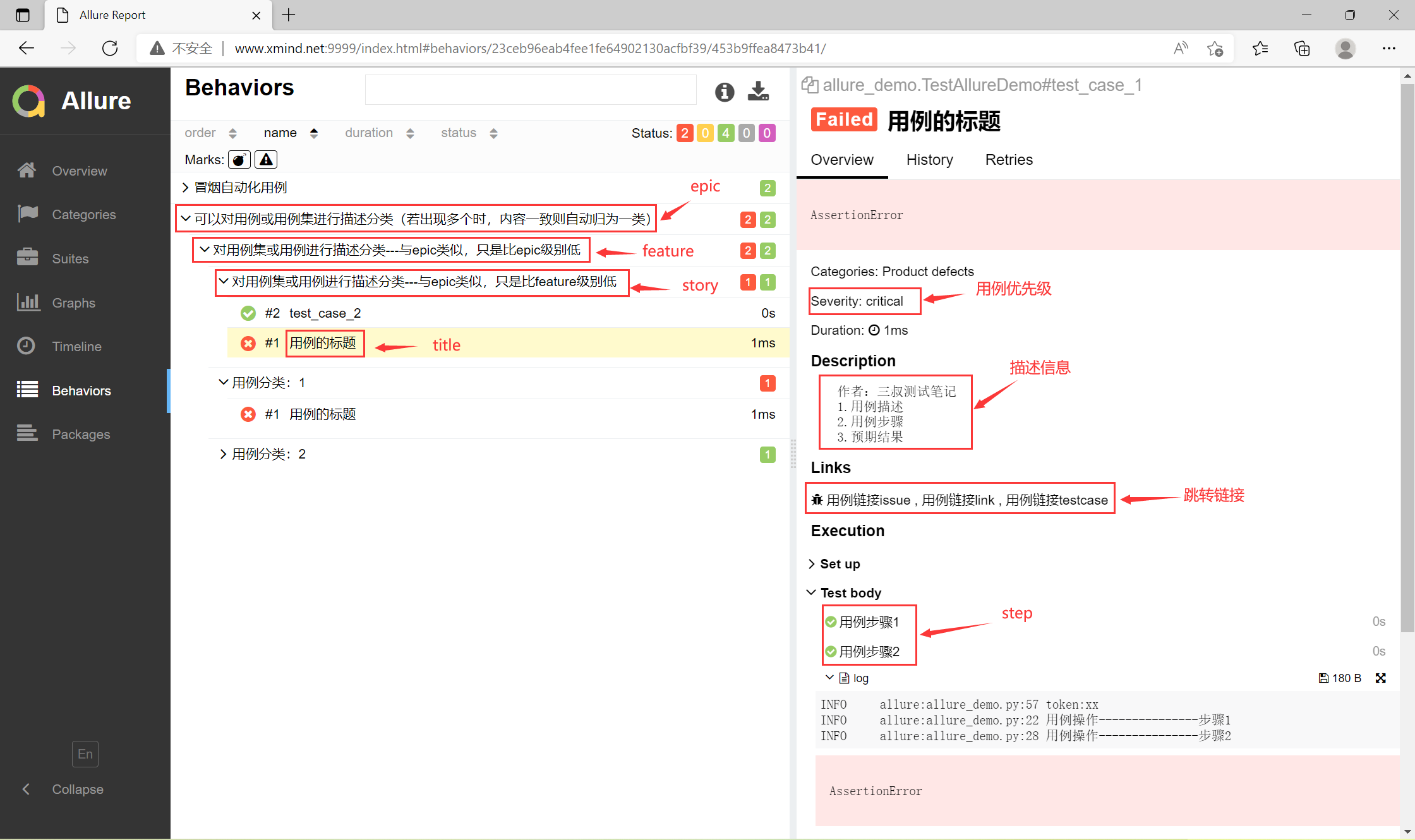前言 allure可以输出非常精美的测试报告,也可以和pytest进行完美结合,不仅可以渲染页面,还可以控制用例的执行。下面就对allure的使用进行一个详细的介绍和总结。 需要准备的环境
allure可以输出非常精美的测试报告,也可以和pytest进行完美结合,不仅可以渲染页面,还可以控制用例的执行。下面就对allure的使用进行一个详细的介绍和总结。
需要准备的环境:
- python
- pytest
- allure-pytest
- allure工具
# -*- coding:utf-8 -*-
"""
@File: allure_demo.py
@Author: 三叔测试笔记
@Time : 2022/3/18 8:34
@Description: allure使用介绍
"""
import pytest
import allure
from base.log import Logger
logger = Logger(logger_name='allure', level='error').get_logger()
@pytest.fixture(scope="session") # 用例前置操作
def login_fixture():
# 比如登录获取token操作
return "token:xx"
@allure.step("用例步骤1")
def step_1():
logger.info("用例操作---------------步骤1")
return True
@allure.step("用例步骤2")
def step_2():
logger.info("用例操作---------------步骤2")
return False
@allure.step("用例步骤3")
def step_3():
logger.info("用例操作---------------步骤3")
return True
@allure.epic("可以对用例或用例集进行描述分类(若出现多个时,内容一致则自动归为一类)")
@allure.feature("对用例集或用例进行描述分类---与epic类似,只是比epic级别低")
@allure.story("对用例集或用例进行描述分类---与epic类似,只是比feature级别低")
class TestAllureDemo:
@allure.testcase("https://xxx/testcase/list",
name='用例链接testcase') # 为了更好的链接到问题分类或者bug、测试用例地址中(url、name两个参数,可不填写name;可以用@allure.link)
@allure.link("https://xxx/testcase/list", name='用例链接link') # 与testcase没有多大区别,从可读性角度还是建议选择@allure.link
@allure.issue("https://xxx/testcase/list", name='用例链接issue') # 与testcase区别在于有小虫子图标
@allure.title("用例的标题") # 可参数化标题
@allure.story("用例分类:1") # 可参数化标题
@allure.severity("critical") # 用例等级(blocker critical normal minor trivial)
def test_case_1(self, login_fixture):
"""
1.用例描述
2.用例步骤
3.预期结果
"""
logger.info(login_fixture) # 获取用例前置的信息,比如登录token
assert step_1()
assert step_2()
@allure.story("用例分类:2")
def test_case_2(self, login_fixture):
logger.info("测试用例2")
assert step_1()
assert step_3()
@allure.epic("冒烟自动化用例")
class TestDemo2:
@allure.story("用例分类:3")
def test_case_3(self, login_fixture):
logger.info("测试用例3")
step_1()
@allure.story("用例分类:4")
def test_case_4(self, login_fixture):
logger.info("测试用例4")
step_3()
pytest执行用例时可以加上allure的标记参数,可以控制执行哪些用例。
--allure-severities=SEVERITIES_SET
Comma-separated list of severity names. Tests only
with these severities will be run. Possible values
are: blocker, critical, normal, minor, trivial.
--allure-epics=EPICS_SET
Comma-separated list of epic names. Run tests that
have at least one of the specified feature labels.
--allure-features=FEATURES_SET
Comma-separated list of feature names. Run tests that
have at least one of the specified feature labels.
--allure-stories=STORIES_SET
Comma-separated list of story names. Run tests that
have at least one of the specified story labels.
--allure-link-pattern=LINK_TYPE:LINK_PATTERN
Url pattern for link type. Allows short links in test,
like 'issue-1'. Text will be formatted to full url
with python str.format().
# 选择运行你要执行epic的用例
pytest --alluredir ./report/allure --allure-epics=epic对大Story的一个描述性标签
# 选择运行你要执行features的用例
pytest --alluredir ./report/allure --allure-features=模块2
# 选择运行你要执行features的用例
pytest --alluredir ./report/allure --allure-stories="用户故事:1"
-
命令行模式下运行pytest,生产测试结果文件
pytest demo.py --alluredir ./report/allure -
allure程序启动已经生产的文件
allure serve ./report/allure
- 编写启动方法,运行pytest
pytest.main([allure_demo.py, "--alluredir", "report/result"])
- 使用进程,开启allure服务
import subprocess
subprocess.call('allure generate report/result/ -o report/html --clean', shell=True)
subprocess.call('allure open -h 127.0.0.1 -p 9999 ./report/html', shell=True)
五、报告效果图及注解(两种方法都需要安装allure工具)

进群交流、获取更多干货, 请关注微信公众号:

> > > 咨询交流、进群,请加微信,备注来意:sanshu1318 (←点击获取二维码)
> > > 学习路线+测试实用干货精选汇总:
https://www.cnblogs.com/upstudy/p/15859768.html
> > > 【自动化测试实战】python+requests+Pytest+Excel+Allure,测试都在学的热门技术:
https://www.cnblogs.com/upstudy/p/15921045.html
> > > 【热门测试技术,建议收藏备用】项目实战、简历、笔试题、面试题、职业规划:
https://www.cnblogs.com/upstudy/p/15901367.html
> > > 声明:如有侵权,请联系删除。
============================= 升职加薪 ==========================
更多干货,正在挤时间不断更新中,敬请关注+期待。
